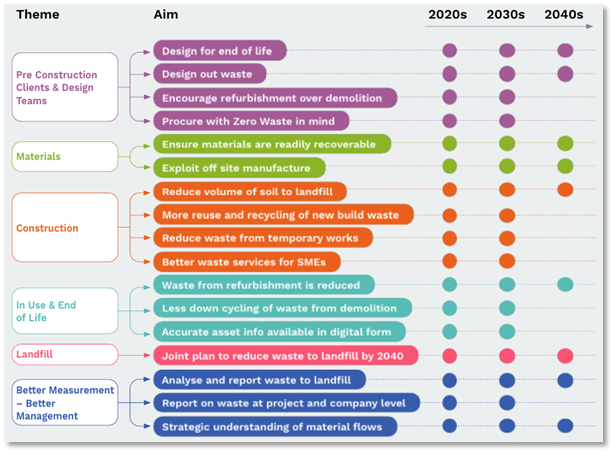Sept 15, 2025 | PJ Kirk
The UK construction sector is at the heart of the nation’s journey to a more sustainable, circular economy. It’s also at the centre of one of the biggest challenges: waste.
Construction and the built environment accounts for between 60 - 65% of the UK’s total waste, generating over 60 million tonnes of non-hazardous waste per year. This costs the UK economy £11 billion per year, and releases 3.5 million tonnes of CO₂e into the atmosphere.
In response, the Green Construction Board has introduced the Zero Avoidable Waste Routemap; a strategic plan which aims to transform the way the construction sector manages materials and waste. The routemap forms part of the UK Governments Resources and Waste Strategy (2018) wish aims to ‘to eliminate avoidable waste of all kinds by 2050’.
The Green Construction Board is a delivery body for the Net Zero and sustainability workstream of the Construction Leadership Council (CLC). It focuses on coordinating net-zero, waste reduction, and sustainability efforts across government departments and construction sector stakeholders.
What is “Zero Avoidable Waste”?
The scope and interpretation of “Zero Avoidable Waste” is broad and complex, and considers a variety of factors. In brief, Zero Avoidable Waste in construction means preventing waste from being generated at every stage of a project’s lifecycle including manufacturing and design; procurement and assembly; through to deconstruction and demolition.
It also requires that, at end of life, products, components, and materials are recovered at the highest level of the waste hierarchy; prioritising reuse over recycling, while ensuring minimal environmental impact.
This working interpretation, developed collaboratively by the Green Construction Board’s Resources & Waste Task Group in partnership with both BEIS and DEFRA, emphasizes two main focal points.
First, new structures should be designed for adaptability, longevity, and eventual disassembly or reuse. Second, existing buildings should be repurposed where possible, and, if not, demolished strategically so that the maximum amount of material can be recovered, reinforcing the circular economy approach
Objectives & Targets
The overall objective of the routemap is to achieve “zero avoidable waste (ZAW) in the construction sector by 2050, delivered through targets that aim to prevent and minimise waste at source; maximise material reuse; and divert resources from landfill wherever possible. Key targets and timelines include achieving:
- A 10% cost reduction by 2030 through smarter material optimisation
- A 75% reduction in soil sent to landfill by 2040
- Zero landfill (except hazardous waste) by 2050
Making Sense of the Routemap
The Routemap is comprised of several themes, each with their own objectives, timelines, and targets.

Zero Avoidable Waste Routemap Summary
Pre Construction Clients & Design Teams
Contractors must embed waste prevention and minimisation in their projects from the beginning. They must consider end of life, waste minimisation, sustainable procurement, and seek identify opportunities for refurbishment and reuse of existing structures.
Materials
Modular, and offsite manufacturing can help minimise waste through increased productivity and efficiency, capable of reducing on site waste by up to 70%. Contractors must also prioritise the use of materials that can be recovered to the highest waste value possible at the end of their life.
Construction
Soil from excavation accounts for over 40% of waste in the construction sector, and while it may seem like a “safe” form of waste, it still represents a significant carbon and economic cost. More broadly, organisations must make efforts to identify opportunities to reuse and recycle new build waste materials, reduce waste from temporary works.
In Use & End of Life
The focus is on reducing waste during refurbishment, ensuring that materials removed or replaced are reused rather than downcycled, and minimising unnecessary disposal. Accurate, up-to-date asset information in digital form supports these goals by making it easier to plan maintenance, upgrades, or deconstruction in a way that preserves material value and keeps resources circulating within the economy.
Landfill
Government and industry will work in collaboration to reduce, and ultimately eliminate, avoidable construction and demolition waste to landfill by 2040. Progress will be tracked annually, and regulatory or fiscal measures may be introduced if needed. Ultimately, only hazardous waste that cannot be prevented or recovered will be sent to landfill.
Better Measurement, Better Management
Technology will play a central role in the delivery of these objectives. Accurate measurement and monitoring of waste streams will allow teams monitor performance, make informed decisions, and demonstrate progress over time. This focus ensures that waste reduction efforts are targeted, effective, and continuously improving.
How SustainIQ Can Help
Reaching Zero Avoidable Waste targets requires reliable data, clear insights, and a way to measure progress across every site and project. SustainIQ can help your organisation to report against your Zero Avoidable Waste targets; and to demonstrate progress to clients, regulators, and stakeholders.
By unifying ESG reporting into a single platform, SustainIQ helps construction organisations not only manage waste, but also deliver the social, environmental, and governance outcomes that matter most.
To learn more about how SustainIQ can help your organisation respond to Zero Waste to Landfill requirements, arrange a demo here.
About SustainIQ
SustainIQ is an integrated ESG reporting platform that unifies all aspects of an organisation’s sustainability activities within a single environment. Businesses use SustainIQ to measure, monitor, and report on their social, economic, and environmental performance in real time.
Our software saves sustainability professionals from wasting time chasing teams, sites, and regions for reporting information. No more unreadable spreadsheets, awkward (and incorrect) calculations, and endless report building. With SustainIQ, simply pull, input or bulk upload data and get access to your custom-built report at touch of a button.
